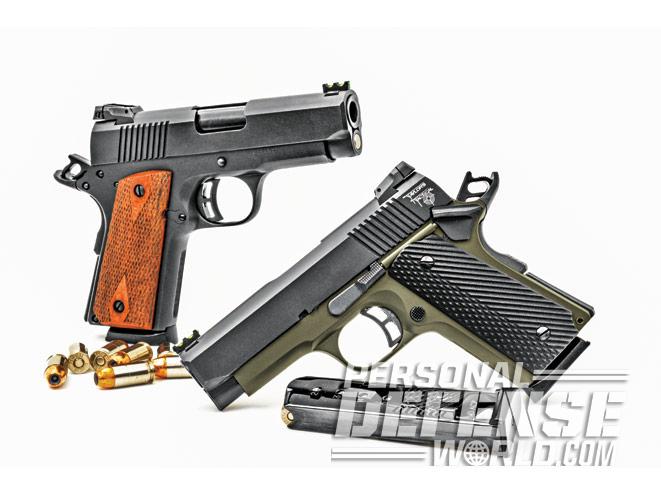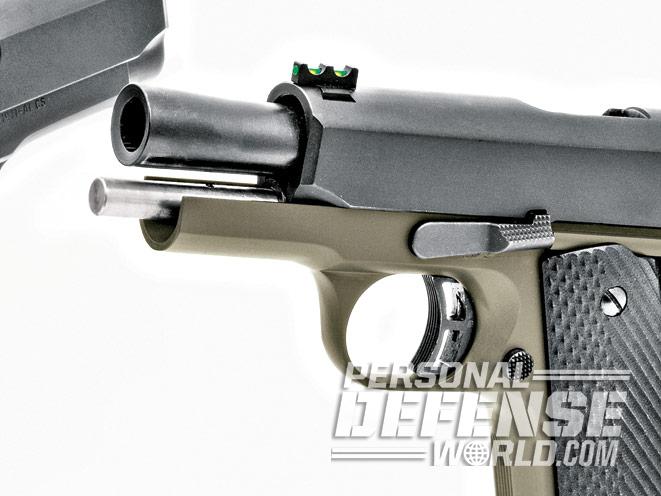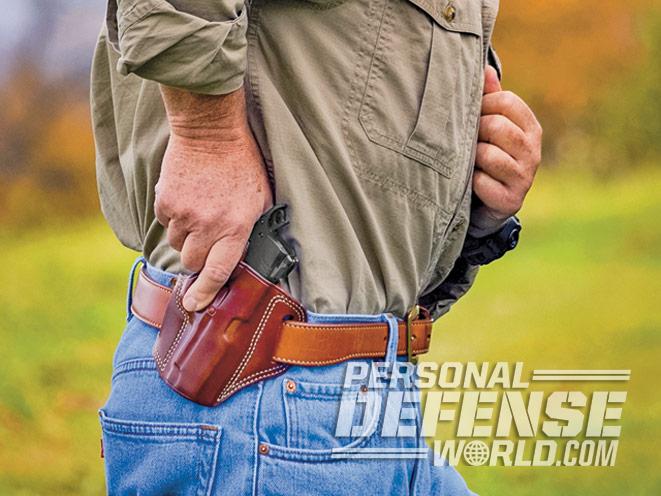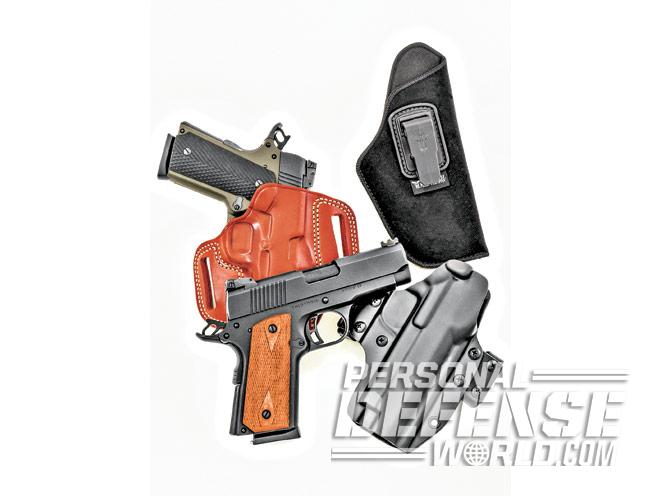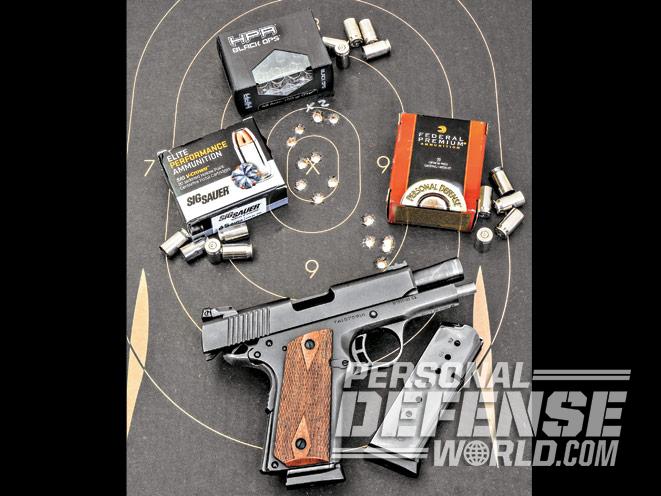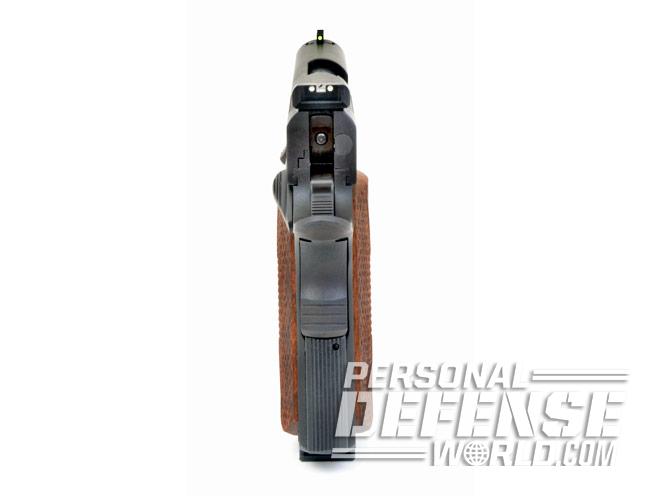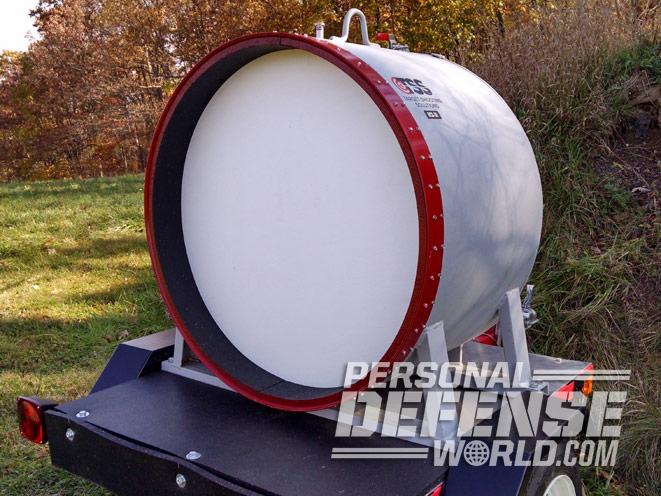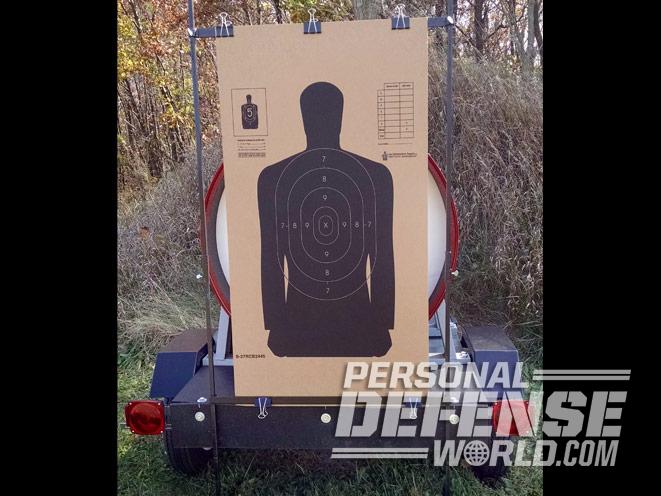There is an old Detroit Automaker’s axiom, “There is no substitute for cubic inches.” While that has been disproved countless times in the automotive world by innovative high-performance, fuel-efficient, smaller displacement engines, that basic tenet of greater cubic inch displacement equaling performance is still applicable when absolute power is paramount, even today. In the world of handguns, the .45 ACP is without question the “big block” of semi-auto cartridges. If this were not so, U.S. Special Forces and elite Marine Corps units (among others) would not be using .45 ACPs in the 21st century.
In the law enforcement community this holds true for scores of state and local Special Response Teams (a gentler, kinder re-branding of SWAT), as well as for civilians whose needs may require a gun with proven stopping power. No matter how you break it down, the best handgun for the job ends up being a 1911-style semi-automatic pistol chambered in .45 ACP. This is quite the triumph for a design that was developed more than 100 years ago.
Undercover Classic
Advertisement — Continue Reading Below

For concealed-carry use, the marketplace is rich in Commander-sized 1911s today, as well as a handful of 1911s scaled down to even smaller dimensions for specific CCW use. In general, the compact Commander-style 1911 is the most practical for size, balance and capacity in the majority of concealed-carry situations. Government-sized models are harder to conceal. Lighter-weight, scaled-down 1911s are easier to carry but often sacrifice capacity and ease of handling for their smaller dimensions. If we call ourselves “1911 purists” who prefer a proven design, (i.e., the familiarity of operation), then the Taylor’s Tactical Compact Carry 1911 meets the majority of user demands.
The new Taylor’s & Company Tactical Compact Carry models come standard with upgraded features that include a 3.6-inch, tapered bull barrel, a heavy-duty recoil spring and full-length guide rod, dovetailed Novak-style rear sights, a green fiber-optic front blade, a flat mainspring housing, a serrated palm swell safety and extended beavertail, a skeletonized/grooved trigger, a Commander-style (Delta) hammer, 7+1 capacity and Cerakote or nitride black finishes. These are all features that individually increase the price of a custom-built 1911. But with a retail of $814, the Taylor’s Compact Carry is a lot of gun for the money.
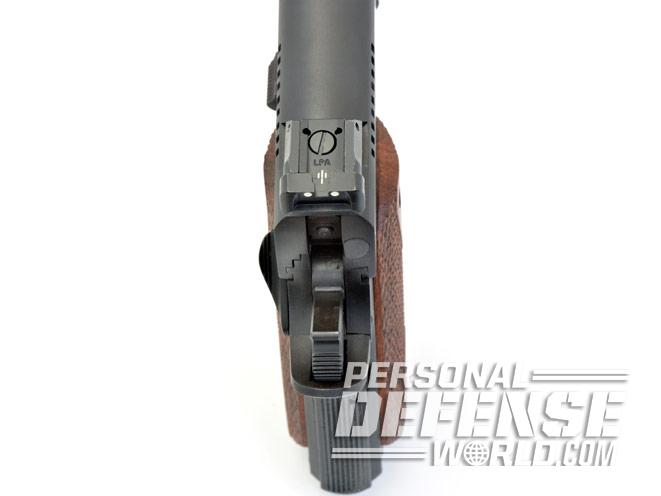
Advertisement — Continue Reading Below
Taylor’s & Company has all of its 1911 models (and it has everything from deluxe, hand-engraved, nickel-plated 1918 versions to WWI/WWII 1911-A1 variations, compacts and modern rail guns) built to its specifications by one of the largest manufacturers of 1911s in the world, Armscor. Located in the Philippines, Armscor builds more variations of the 1911 than any other manufacturer in the world, with more than 30 models, and its top-end guns are built to perform muzzle to muzzle with 1911s costing considerably more.
RELATED STORY: The Reliable & Accurate Taylor’s Tactical 1911-A1
The Taylor’s Compact Carry is offered in Cerakote Gun Metal Grey, Cerakote Coyote Tan, OD green and Nitride black, with matching or contrasting G10 grips or early GI-style, checkered, diamond-pattern walnut grips. Overall length for the Compact Carry is 7.5 inches, height is 5.25 inches (top of sight to bottom of extended base pad), slide and frame width is 0.875 inches (1.18 with grips), and the carry weight 37.5 ounces.
Advertisement — Continue Reading Below
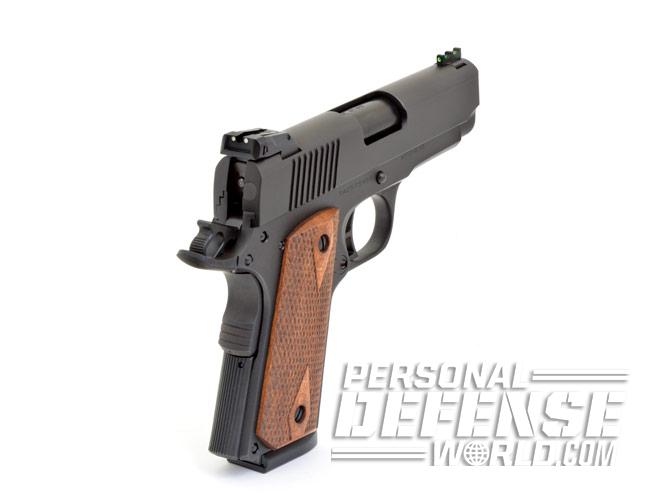
Based on Colt Series-70 designs, Taylor’s 1911s are built to exhibit fine fit, finish and exceptionally close tolerances between the outer dimension of the slide and inner dimension of the frame rails. You won’t hear one of Taylor’s 1911s rattle when you shake it, it’s as quiet as a vault. You can’t say that for every 1911 on the market today. In addition, the heavy-duty recoil spring and full-length guide rod contribute to making the guns easier to handle while also reducing felt recoil and muzzle lift. Conversely, these features make chambering the first round, clearing the action and field stripping the guns a bit more demanding.
The Compact Carry’s slide has nine deeply cut rear serrations, the dovetailed Novak-style rear sights are adjustable for windage and elevation, and the front fiber optic is interchangeable for another color, if desired. The rear sights have rounded edges to prevent them from snagging on clothing, but those rounded edges also save hands from the minor cuts occasionally received from traditional straight-edged adjustable rear sights. The slide releases are deeply checkered for a solid purchase when dropping the slide on the reload, and the Compact Carry also has a single, 1911-A1 GI-style thumb safety.
Advertisement — Continue Reading Below
Everyday Carry

For the range test, the Compact Carry was holstered in three different design rigs, the latest Galco Combat Master belt holster for 3.5-inch models, the new injection-molded, Commander-sized Blade-Tech OWB Eclipse belt holster and Blade-Tech’s new Soft Holster for inside-the-waistband (IWB) carry with medium- to large-frame semi-autos.
RELATED STORY: New For 2015 – Taylor’s & Co Ridge Runner, Updated 1911s | VIDEO
Advertisement — Continue Reading Below
One of the most established CCW holster designs in the world, the Galco Combat Master uses double-stitched pancake construction for wearer durability and a pouch contoured to the gun’s profile to provide solid retention with a traditional open-top style. Although offering no additional retention other than the contoured pouch, this remains one of my personal favorites for 1911 carry, as it gives the gun excellent cover and the closely contoured fit around the pistol keeps it securely in place. The Blade-Tech Eclipse is a Level I design by virtue of the injection-molded contour locking feature, which secures the gun until it is pulled briskly from the holster to release the tension hold on the triggerguard.
The Blade-Tech Soft Holster is a new design for IWB carry with a suede-like finish and a large, injection-molded belt clip that firmly locks around the underside of the wearer’s belt to keep the IWB rig in place. The high-rise soft pouch also does an excellent job of isolating the gun from the body for greater IWB comfort. All three worked ideally with the Compact Carry models.
Range Time
Advertisement — Continue Reading Below
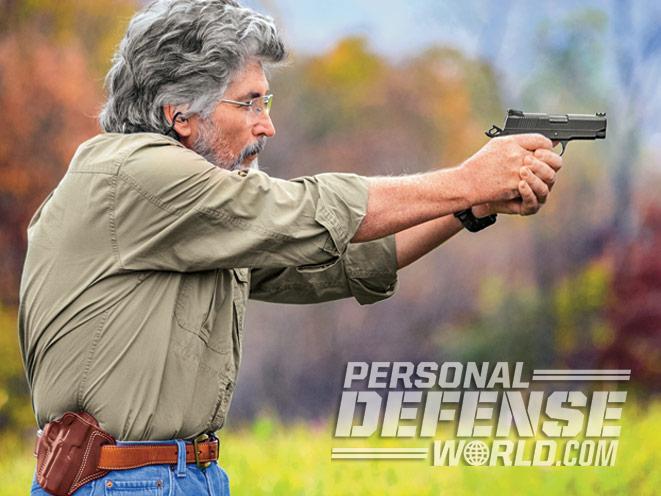
The GI-style thumb safety on the Compact Carry is very easy to operate and clicks solidly into and out of lock. The smooth operation of the safety and slide release is another sign of a quality fit. The G10 grips and grip strap serrations provided a solid, tactile surface for either bare hands or gloves, and even the handsome, finely checkered diamond-pattern walnut grips had the solid feel of an original 1911 pistol.
RELATED STORY: Tale of Two Taylor’s: Tactical 1911 Compact Carry & Tactical 1911 Full Size
Advertisement — Continue Reading Below
Looking downrange, the Novak-style white-dot rear and green fiber-optic front sights were very easy to acquire and, more importantly, reacquire when firing the heavier-recoiling defensive ammunition. Trigger pull was excellent on both test guns with very quick reset. The skeletonized trigger averaged a smooth 6.8 pounds with a short 0.125-inch take-up, a crisp break and quick reset.
Firing off-hand using a two-handed hold and a Weaver stance, five-round strings were fired from 15 yards at a regulation Law Enforcement Targets cardboard B-27 silhouette placed in front of a Target Shooting Solutions BCS-36 bullet trap. This is the largest TSS model with a 36-inch-diameter target surface. The BCS-36 is used by military and law enforcement for training, and is large enough that it can be set up on a DOT-inspected trailer for easy repositioning and moving from location to location. The BCS-36 uses 12 heavy rubber composite baffles that can stop anything up to a .50 BMG round from point-blank range. Target Shooting Solutions also builds smaller-diameter bullet traps as well as clearing stations currently used by law enforcement, the military and police forensics labs for ballistics testing.

Test ammunition was new HPR Black Ops 150-grain OTF, 200-grain Sig Sauer Elite Performance V-Crown jacketed hollow-point (JHP) and heavyweight Federal Premium Hydra-Shok Personal Defense 230-grain JHP. The lightweight 150-grain Black Ops cleared the ProChrono traps at a smoking 1,005 feet per second (fps), which is fast for a 3.6-inch barrel, while the Sig Sauer clocked 848 and Federal slammed home at 768 fps average.
Advertisement — Continue Reading Below
Recoil with the Compact Carry was moderate with all but the heavy-hitting Federal rounds. Sig 200-grain JHP was fired first, and all shots hit just above point of aim (POA), measuring 1.5 inches in the “X” bullseye. Moving up slightly, the low-recoiling frangible HPR Black Ops 150-grain put two rounds in almost the same hole at 12 o’clock in the 9-ring, and one to the right and two to the left at 11 o’clock for a group measuring 1.37 inches. Shifting POA right and low, Federal Hydra-Shok JHP grouped slightly wider at 1.44 inches, with two overlapping. All shots hit at 4 o’clock in the nine-ring.
Final Shots
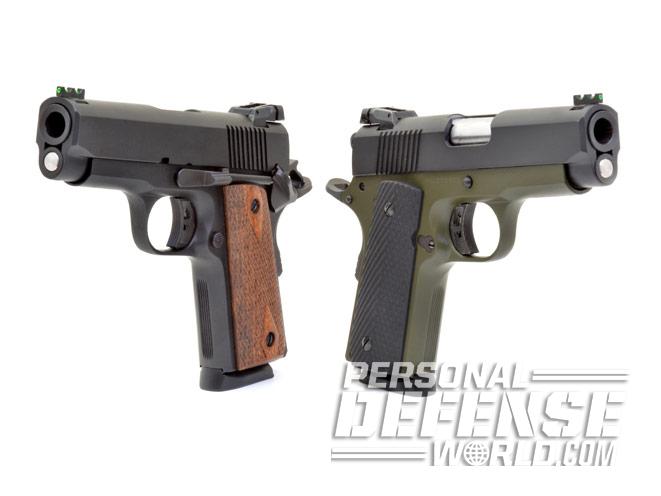
This is not my first dance with the Taylor’s & Co. Armscor-built 1911s and there has been a consistency to every one of the Taylor’s branded models I have tested. All have exhibited a tight fit, excellent Cerakote finishes, reliable operation (short-term testing conditions), excellent sights (with the green fiber-optic front being a Taylor’s exclusive), superior quality grips whether G10 or checkered walnut, well made Italian-built magazines and consistent triggers from one gun to the next. This all stacks up in the plus column for me, and when you factor in all the custom features, the new Compact Carry models are exceptional handguns for out-of-the-box 1911s.
RELATED STORY: Today’s Top 10 Compact 1911 Pistols For Concealed Carry Protection
For More Information
Taylor’s & Co.
http://www.taylorsfirearms.com; 540-722-2017
Blade-Tech
http://www.blade-tech.com; 877-331-5793
Galco
http://www.galcogunleather.com; 800-874-2526
Target Shooting Solutions
http://www.targetshootingsolutions.com; 610-268-3333
